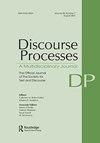用文本分析法衡量儿童图画书中的文本社会信息
IF 2.1
2区 心理学
Q2 PSYCHOLOGY, EDUCATIONAL
引用次数: 0
摘要
摘要 文本社会信息包括支持真实或假设的人类思维或互动的认知过程和社会交流技能。目前衡量文本社会信息的标准是体裁。然而,体裁是一种有限的衡量标准,因为其可操作性差、特异性有限,而且与结构和语言差异重叠。本研究旨在开发一种自动文本分析方法,以衡量儿童图画书中超越体裁的文本社会信息。研究 1 和研究 2 发现了几种捕捉文本社会信息的测量方法的收敛有效性和发散有效性,与非虚构类图书相比,这些测量方法在儿童虚构类图书中的使用率明显更高,而且与其他结构和语言文本测量方法没有关联。研究 3 通过主成分分析发现了文本社交信息的两个组成部分。这两个组成部分分别反映了一般社会性因素(即心智理论、情感和社会关系)和语用/对话。研究 4 为文本社交信息测量的预测有效性提供了初步证据。总之,本研究为测量文本社交信息提供了一套初步的连续测量方法,可以开始推动该领域确定文本社交信息如何影响理解和社交认知。本文章由计算机程序翻译,如有差异,请以英文原文为准。
Text analysis approach to measuring text social information in children’s picture books
ABSTRACT Text social information includes the cognitive processes and social communication skills that support real or hypothetical human thought or interaction. The current measure of text social information is genre. However, genre is a limited measure because of poor operationalization, limited specificity, and overlap with structural and linguistic differences. The purpose of this study was to develop an automated text analysis approach to measure text social information in children’s picture books beyond genre. Studies 1 and 2 found convergent and divergent validity for several measures that captured text social information with these measures being significantly higher in children’s fiction compared to nonfiction books and not correlated with other structural and linguistic text measures. Study 3 found two components of text social information, based on a principal component analysis. These two components captured a general socialness factor (i.e., theory of mind, emotions, and social relationships) and pragmatics/conversation. Study 4 provides preliminary evidence for the predictive validity of the text social information measures. Together, this study provides an initial set of continuous measures for measuring text social information that can begin to advance the field in determining how text social information impacts comprehension and social cognition.
求助全文
通过发布文献求助,成功后即可免费获取论文全文。
去求助
来源期刊

Discourse Processes
Multiple-
CiteScore
4.30
自引率
4.50%
发文量
27
期刊介绍:
Discourse Processes is a multidisciplinary journal providing a forum for cross-fertilization of ideas from diverse disciplines sharing a common interest in discourse--prose comprehension and recall, dialogue analysis, text grammar construction, computer simulation of natural language, cross-cultural comparisons of communicative competence, or related topics. The problems posed by multisentence contexts and the methods required to investigate them, although not always unique to discourse, are sufficiently distinct so as to require an organized mode of scientific interaction made possible through the journal.
 求助内容:
求助内容: 应助结果提醒方式:
应助结果提醒方式:


